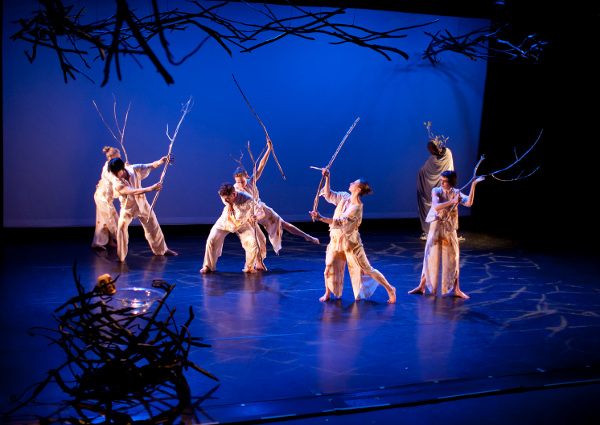
“Beyond the Bones” with Kun-Yang Lin/Dancers and Alison Stigora
If you attended the Painted Bride Art Center this past weekend, you could have been reborn. For three nights, March 29 through 31, the acclaimed Philadelphia dance company Kun-Yang Lin/Dancers graced the stage at the Bride for an evocative performance that drew audience members into a physical and primal world, but one, which also hearkened to a very human spirituality and sense of unity.
All of the movements take place beneath the installations of artist Alison Stigora, who collaborated with the dancers on the set design. It is Stigora’s first time designing for the stage and for dance, but the pairing seems perfectly natural. As it turns out, when Kun-Yang Lin originally choreographed “Beyond the Bones” back in 2002, there were sections where the dancers move with branches. For anyone familiar with Stigora’s work, the connection is less like coincidence and more like destiny; it seems as if her sculptures were always a part of the performance.
A nest-like circle of interwoven sticks wraps around the ceiling, above both the stage and the seats, immediately breaking down the barriers between performers and observers. On the left side of the stage stands a glass bowl of water held up by a meshed structure of branches. Two rickety, wooden hands reach out over the trough but never touch the water’s surface, introducing immediate tension into the action. The wood itself has all been altered in some way. For the above-hanging bundles, it is a metallic sheen. For the water-holding sculpture, some of the sticks have been burnt, adding a transformative exchange between fire and water.
Originally, “Beyond the Bones” was arranged by Kun-Yang Lin after 9/11 and the death of his father. The explorations of the wordless motions venture first into the darkest areas of the mind, only to emerge on the other side refreshed and vivacious. It is a process we all know — the act of mourning or the pain of empathy — but it is revealed to us through the motion of the body in space. Words are unnecessary for the dancers, only the emotion and texture of their movements is important.
There is a distinct division between the dancers near the beginning. One group moves together: they fall, catch one another, interact directly and hold or cradle branches closely. The branches are simultaneously like a dance partner and an extension of themselves. On the flipside, there is one lone, masked figure that moves in opposition to the troupe. The gestures of this dancer are jerky and painful looking, and the other group initially seems frightened or repulsed by this “other”.
While the events run their course, a number of smaller sequences take place. One dancer, for instance, contorts herself around the stage in a solo, holding a bone in her mouth the entire time. This impediment clearly affects her every motion and acts as a focal point during the scene. The masked figure shakes bells in conjunction to the sometimes-erratic movements of that solitary segment.
Aside from the ambient soundtrack of ethereal vocals and occasional samples and electronic sounds, the only sounds are those of the dancers. There are, of course, the bells but also infrequent grunts or exhalations, punctuated by staccato slaps of the floor by sticks or feet. Otherwise, the performers remain silent.
In the end, the masked figure does reach the water and removes her mask. The feelings of liberation and release overtake the room just as a group of white-robed singers stride from behind the audience and venture onstage. At this moment, life begins anew. The grief or anguish that the viewer may have experienced is trounced and gives way to a celebration of beauty in its purest form.
Although the Kun-Yang Lin/Dancers and Aliston Stigora collaboration for “Beyond the Bones” lasted only one weekend, it is without a doubt that both the dancers and the visual artist will walk away from this experience transformed, as well. Having opened themselves up to one another’s processes, their future work will surely be informed by the cooperative efforts they experimented with at the Painted Bride. Both audience and artists were indelibly changed.
The Painted Bride Art Center is located at 230 Vine St.; 215-925-9914.
Recent Content
-
Artsarticle ·
-
Artsarticle ·
-
Artsarticle ·


